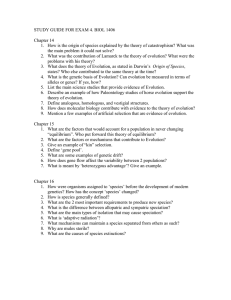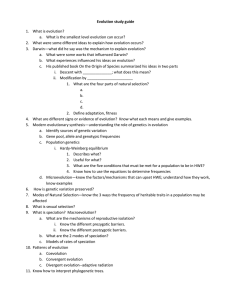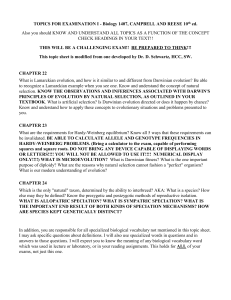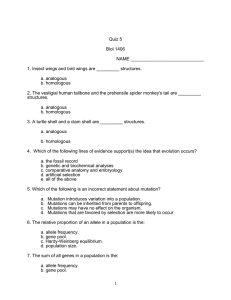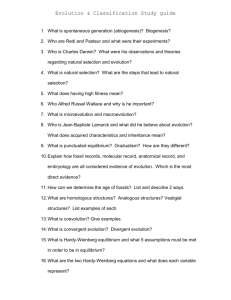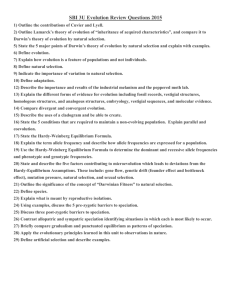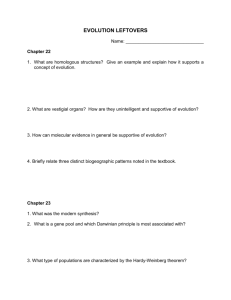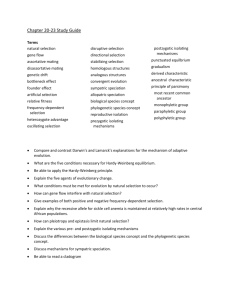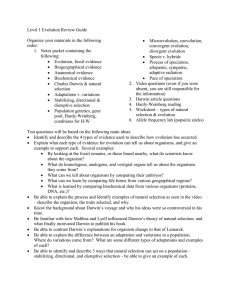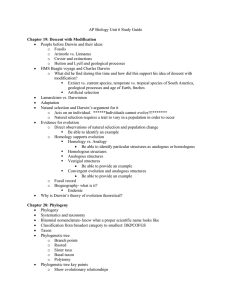Chapter 8 Cellular Energy - Homework and Vocabulary Worksheet
advertisement
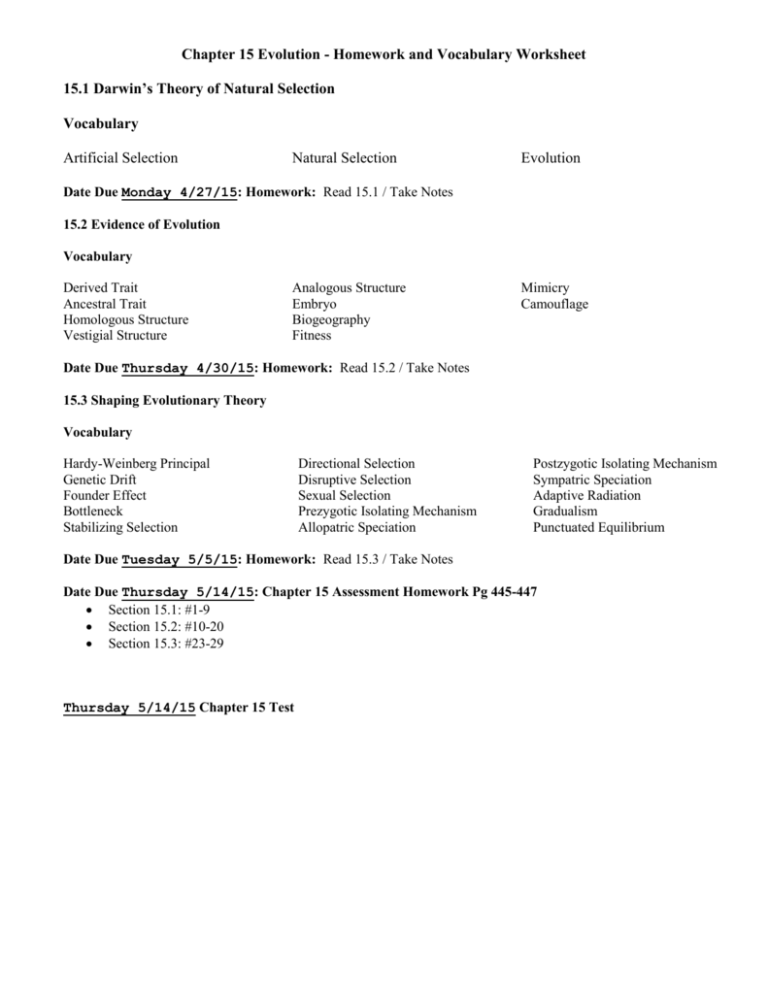
Chapter 15 Evolution - Homework and Vocabulary Worksheet 15.1 Darwin’s Theory of Natural Selection Vocabulary Artificial Selection Natural Selection Evolution Date Due Monday 4/27/15: Homework: Read 15.1 / Take Notes 15.2 Evidence of Evolution Vocabulary Derived Trait Ancestral Trait Homologous Structure Vestigial Structure Analogous Structure Embryo Biogeography Fitness Mimicry Camouflage Date Due Thursday 4/30/15: Homework: Read 15.2 / Take Notes 15.3 Shaping Evolutionary Theory Vocabulary Hardy-Weinberg Principal Genetic Drift Founder Effect Bottleneck Stabilizing Selection Directional Selection Disruptive Selection Sexual Selection Prezygotic Isolating Mechanism Allopatric Speciation Postzygotic Isolating Mechanism Sympatric Speciation Adaptive Radiation Gradualism Punctuated Equilibrium Date Due Tuesday 5/5/15: Homework: Read 15.3 / Take Notes Date Due Thursday 5/14/15: Chapter 15 Assessment Homework Pg 445-447 Section 15.1: #1-9 Section 15.2: #10-20 Section 15.3: #23-29 Thursday 5/14/15 Chapter 15 Test Biology Chapter 15 Exam Review Sheet Extra Credit There is a lot of vocabulary in this chapter and on this test. You will be responsible for knowing all of the vocabulary words in the chapter. Topics 15.1: 1. What was the significance of the Galapagos Islands to Darwin’s studies? 2. What was the name of the book Darwin published? 3. Define Natural Selection. 4. Define Evolution. 5. Natural Selection and evolution are not the same thing. (Pg 422) Give information to support this statement. 6. What is the difference between artificial selection and natural selection? Make sure to define both terms as you answer. 7. Natural selection describes four basic principals that explain how populations can change over time. What are the four principles? Explain each one don’t just list them. (See Pg 421) Topics 15.2: 8. How does the fossil record provide evidence for evolution? 9. Define derived traits and ancestral traits. Give an example of each. 10. Homologous Structures and Analogous Structures are examples of comparative anatomy. Define each of these terms. 11. Are vertebrate forelimbs an example of a Homologous or an Analogous structure? Justify your answer. 12. Explain why a bird’s wing and an insect’s wing are examples of Analogous structures. 13. What is a Vestigial Structure? Give an example. 14. How does comparative embryology support the theory of evolution? 15. What is an embryo? 16. What is comparative biochemistry? 17. Remember back to the amino acid activity we did. Based on amino acid sequences explain how you might know if a type organism is evolutionarily related to another type? 18. Explain fitness. Why is the statement “survival of the fittest” often misunderstood? 19. Define Adaptation. Do organisms “choose” to adapt? Explain why or why not? 20. Define Camouflage and Mimicry. Topics 15.3 21. Define Hardy-Weinberg Principle 22. Problem: You have 20 gold fish. 15 are gold (either FF or Ff) and 5 are brown (ff). Use the hardy-Weinberg equation to determine the allele frequency of the homozygous dominant, heterozygous and homozygous recessive individuals. 23. What does it mean for a population to be at equilibrium? What are the 5 factors necessary for a population to be at equilibrium? Do populations usually stay at equilibrium? Explain you answer. 24. Define Genetic Drift. Founder Effect and Bottleneck are two extreme examples of genetic drift. Define these terms also. 25. Draw the graphs for directional, disruptive and stabilizing selection. Explain what is happening in each graph. 26. Define Sexual Selection. List some examples. 27. What is the difference between Allopatric and Sympatric speciation? Define each of these terms. 28. Define the following terms: Prezygotic Isolation Mechanism and Postzygotic Isolation Mechanism 29. Define Adaptive Radiation. 30. What pattern of evolution did mammals exhibit during the Cenozoic following the extinction of the Dinosaurs? 31. Define co evolution and give an example. 32. Define convergent evolution and give an example. 33. What is the difference between gradualism and punctuated equilibrium? Define each in your answer. 34. What is meant by the “evolutionary arms race”?
